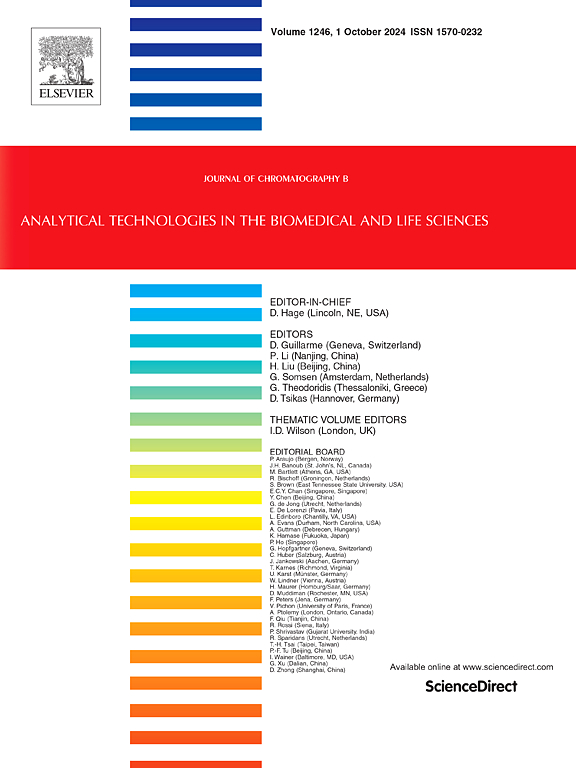表面亲水性聚合物链交联的功能化二氧化硅纳米颗粒膜卷用于直接从大鼠血浆中提取枸杞活性成分
IF 2.8
3区 医学
Q2 BIOCHEMICAL RESEARCH METHODS
引用次数: 0
摘要
evolodiae Fructus (EF)的主要活性成分是evolodiae Fructus (EF)中的evolodiamine等吲哚类生物碱,在中药中有着广泛的应用。近年来,由生物碱evoldiamine引起的EF毒副作用逐渐引起研究者的关注。因此,快速准确地检测生物体液中的生物碱已成为一项具有挑战性的任务。因此,从血液样品中快速高效地提取evolodiamine等生物碱已成为当务之急。在本研究中,提出了一种用亲水性聚甲基丙烯酸羟乙酯(p-HEMA)在表面交联疏水功能二氧化硅纳米颗粒制备限制通路(RA)膜的新方法。聚hema链起蛋白排斥作用,功能纳米颗粒起疏水吸附剂作用。将RA膜卷成卷状,插入1 mL医用注射器中,组装便携式SPE装置SRAMR-SPE,用PBS简单稀释后,直接同时提取大鼠血浆中的evolodiamine (EVO)、rutecarpine (RUT)和dehydroevolodiamine (DHE)。利用傅里叶变换红外光谱仪(FT-IR)、透射电子显微镜(TEM)、x射线光电子能谱(XPS)和扫描电子显微镜(SEM)对制备的功能纳米粒子和RA膜进行了表征。采用高效液相色谱-紫外分光光度法考察SRAMR的提取性能。建立了SRAMR-SPE- hplc相关联方法,并在方法验证后应用于真实大鼠血浆的检测,验证了SRAMR-SPE的可靠性和适用性。实验结果表明,RA膜卷(RAMR)具有良好的血浆蛋白排除能力和多次重复使用的吸附分析物能力。SRAMR-SPE连续3个循环,测定3种成分在3个浓度水平下的提取回收率分别为:DHE 93.1 ~ 95.1%、EVO 88.8 ~ 91.6%、RUT 93.6 ~ 95.6%,整个SRAMR-SPE- hplc - uv法的绝对回收率分别为:DHE 90.3 ~ 92.3%、EVO 86.2 ~ 90.9%、RUT 91.8 ~ 96.4%。线性范围分别为0.0600 ~ 6.00 μ mL−1 (DHE)、0.105 ~ 5.65 μ mL−1 (EVO)和0.0632 ~ 6.32 μ mL−1 (RUT)。本文章由计算机程序翻译,如有差异,请以英文原文为准。
Restricted access membrane roll with functionalized silica nanoparticles cross-linked by hydrophilic polymer chains on the surface for the direct extraction of Evodiae Fructus active components from rat plasma
Evodiamine and other indole alkaloids are the main active constituents in Evodiae Fructus (EF), which is widely applied in traditional Chinese medicine. Recently, the toxic side effects of EF caused by the alkaloid evodiamine have gradually attracted the attention of researchers. In this regard, the rapid and accurate detection of these alkaloids in biological body fluids has become a challenging task. Therefore, it has become a priority that the rapid and efficient extraction of evodiamine etc. alkaloids from blood sample. In this research, a novel method was proposed to prepare the restricted access (RA) membrane with the hydrophobic functional silica nanoparticles cross-linked on the surface by hydrophilic poly-hydroxyethyl methacrylate (p-HEMA). The poly-HEMA chains played the role of protein exclusion and the functional nanoparticles played the role of hydrophobic adsorbent. The RA membrane was wound into a roll shape and inserted into a 1 mL medical syringe to assemble a portable SPE device, named as SRAMR-SPE, for the direct and simultaneous extraction of evodiamine (EVO), rutecarpine (RUT) and dehydroevodiamine (DHE) in rat plasma after a simple dilution with PBS. The prepared functional nanoparticles and RA membrane were characterized by Fourier transform infrared (FT-IR) spectrometer, transmission electron microscopy (TEM), X-ray photoelectron spectroscopy (XPS) and scanning electron microscope (SEM), respectively. HPLC-UV analysis was used to investigate the extraction performance of SRAMR. An associated SRAMR-SPE-HPLC method was constructed and applied to the detection of real rat plasma after the method validation for the verification of the reliability and applicability of the SRAMR-SPE. The experimental results showed that the RA membrane roll (RAMR) had a good ability to exclude plasma proteins and adsorb analytes with multiple reusability. For 3 consecutive cycles of SRAMR-SPE processes, the extraction recoveries of three components at three concentration levels were determined as follows: DHE 93.1–95.1 %, EVO 88.8–91.6 % and RUT 93.6–95.6 %, and the absolute recoveries of the entire SRAMR-SPE-HPLC-UV method were separately as follows: DHE 90.3–92.3 %, EVO 86.2–90.9 %, RUT 91.8–96.4 %. The linear ranges were detected as follows: 0.0600–6.00 μg mL−1 (DHE), 0.105–5.65 μg mL−1 (EVO) and 0.0632–6.32 μg mL−1 (RUT).
求助全文
通过发布文献求助,成功后即可免费获取论文全文。
去求助
来源期刊

Journal of Chromatography B
医学-分析化学
CiteScore
5.60
自引率
3.30%
发文量
306
审稿时长
44 days
期刊介绍:
The Journal of Chromatography B publishes papers on developments in separation science relevant to biology and biomedical research including both fundamental advances and applications. Analytical techniques which may be considered include the various facets of chromatography, electrophoresis and related methods, affinity and immunoaffinity-based methodologies, hyphenated and other multi-dimensional techniques, and microanalytical approaches. The journal also considers articles reporting developments in sample preparation, detection techniques including mass spectrometry, and data handling and analysis.
Developments related to preparative separations for the isolation and purification of components of biological systems may be published, including chromatographic and electrophoretic methods, affinity separations, field flow fractionation and other preparative approaches.
Applications to the analysis of biological systems and samples will be considered when the analytical science contains a significant element of novelty, e.g. a new approach to the separation of a compound, novel combination of analytical techniques, or significantly improved analytical performance.
 求助内容:
求助内容: 应助结果提醒方式:
应助结果提醒方式:


